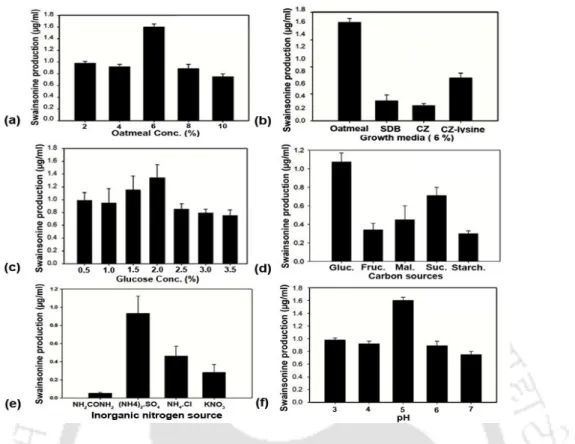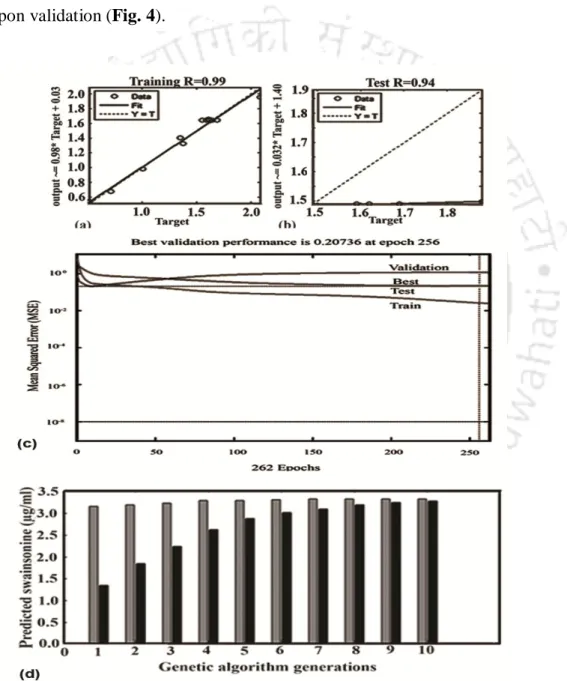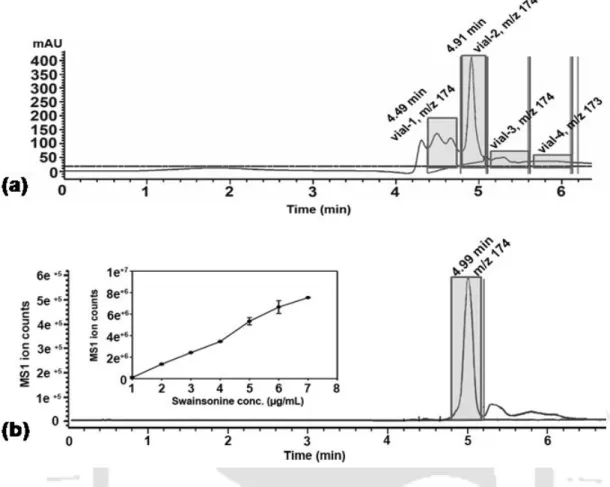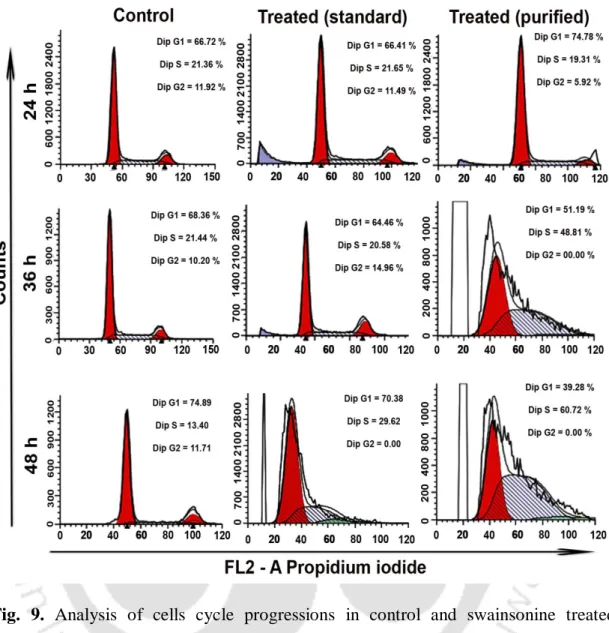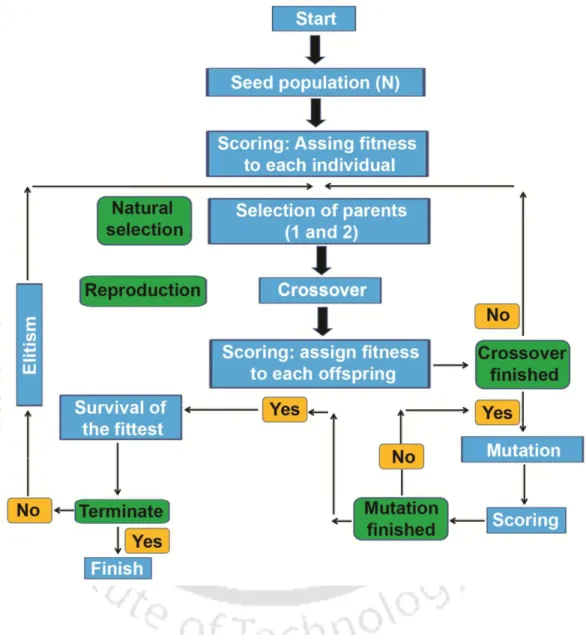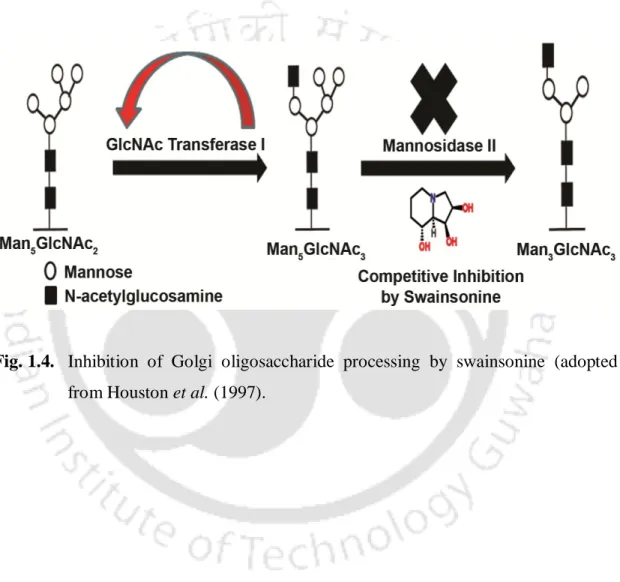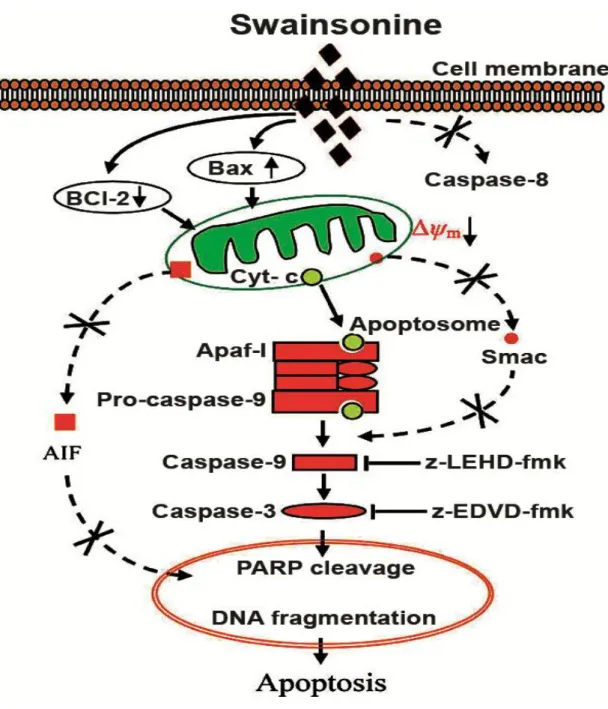The extraction and purification of swainsonins have been reported from the plant sources, Astragalus (Zhao et al., 2009) and Oxytropis (Gardner et al., 2003; Wang et al., 2011). There are two reasons for this: (i) the lack of suitable chromophore and (ii) the extreme hydrophilicity and polarity of swainsonins (Stockigt et al., 2002).
Screening of Metarhizium strains, media components and physiological culture conditions for fermentative swainsonine
Optimization of media components, operation conditions and scale up parameters from shake flask to bench-top bioreactor levels
Chapter 4: Purification, characterization and quantitative analysis of swainsonine
Analysis of in situ entomotoxic and anticancer activities of swainsonine
List of abbreviations
List of mathematical symbols and Greek letters RESEARCH OUTPUT
Screening of Metarhizium strains, media components and physiological culture conditions for fermentative swainsonine
Three-dimensional response surface plots for swainsonine production (a) glucose and oats, (b) semolina and CaCl2, (c) semolina and inoculum size, and (d) CaCl2 and inoculum size. Evolutionary program (EP)-based simulations (1-10), experimental validation of EP-optimized (11) and OFAT-optimized (12) models with different hourly agitation (N) and aeration (Q) rates different incubation (h) with regard to the production of swainsonine.
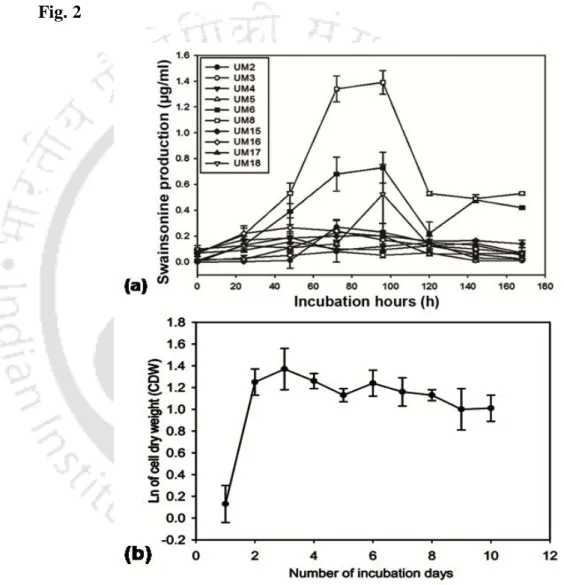
Purification, characterization and quantitative analysis of swainsonine
A simple, rapid and fairly reliable UV-HPLC analytical method was developed for swainsonins in Metarhizium fermentation broth. The mass derivative (m/z)-based rapid preparative analytical method was developed for swainsonine in broth fractions, where the alkaloid as MS1 fraction [M+H at 4.91±0.04 min. was eluted.
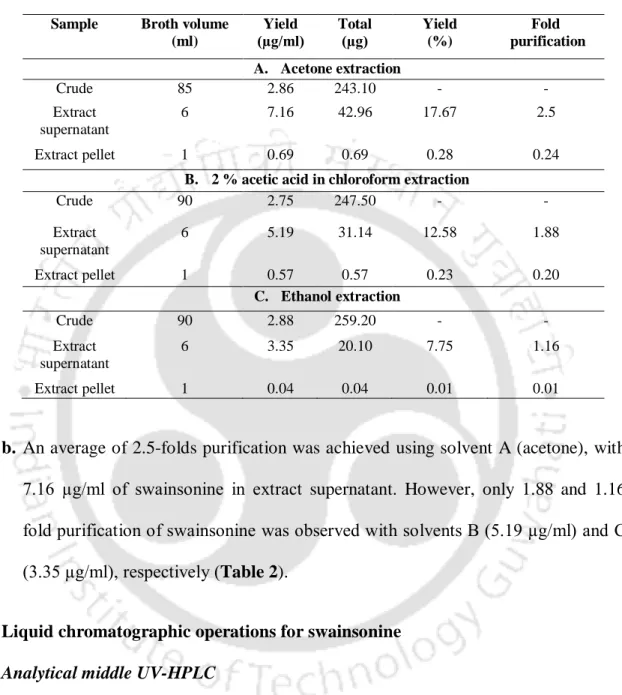
The quantitative analysis of apoptotic/cell cycle regulatory effects of swainsonine in the Sf-21 and HL-60 cells was evaluated by FACS (fluorescence activated cell sorting) based methods. Analysis of cell cycle progression in control and swainsonine-treated (standard and purified) HL-60 cells.
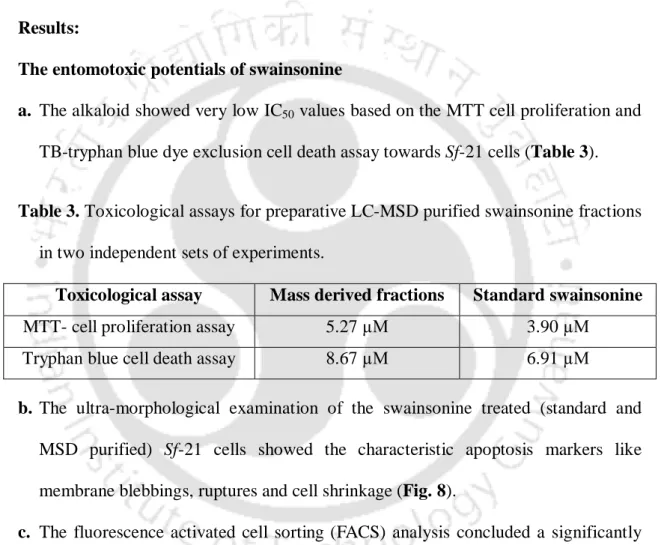
Introduction, Review of Literature and Objectives
Introduction
Mycobiocontrol is the use of fungi in biological processes to lower the insect density with the aim of reducing disease-producing activity and consequently crop damage. Mycobiocontrol is an environmentally sound and effective way to reduce or mitigate insect pests and their effects through the use of natural enemies.
Entomopathogenic fungi
Secondary metabolites are natural products that are not essential for the normal growth, development or reproduction of an organism. However, these bioactive secondary metabolites play a vital role in fungal survival, interspecies interactions, signaling as well as defense against predators and pathogens in their environment.
Bioactive secondary metabolites from Metarhizium
- Viridoxin
- Ovalicin
- Destruxin
- Swainsonine
In some other studies, aflatoxins produced by Aspergillus flavus (Diener et al., 1987), ochratoxins produced by A. The ionophore properties of Dx A allow calcium ion mobilization across liposomal membrane barriers (Hinaje et al., 2002).
Fermentative production of swainsonine from Metarhizium anisopliae In despite of extraction from plants and chemical modes of synthesis, the
- Parameters and optimization models for fermentative production
- One factor at a time and Plackett-Burman screening and optimization
- Hybrid genetic algorithms: Artificial neural network- genetic algorithm In recent years, genetic algorithm (GA) based on ANN model as an objective
It is found in a number of different plants causing a lysosomal storage disease (Dorling et al., 1980) known as locoism in the western USA (Molyneux and James, 1982). Data to the network is presented at input layer and the response of the network to the given data is produced in the output layer.
Downstream recovery of swainsonine 1. Partial purification and solvent extraction
- Chromatographic purification
- Ion Exchange chromatography
- Thin layer chromatography
There are many optimal design methods which combine the optimization algorithms with the computer simulations that have been reported for fermentation modeling (Abakarov et al., 2009; Guo et al., 2010). However, the acetate derivatives must again be deacetylated to obtain the biochemically active swainsonine again after elution (Harris et al., 1988).
Analysis and detection of swainsonine
- Enzymatic Assay
- Thin layer chromatography
- Gas chromatography and gas chromatography-mass spectrometry
- Liquid chromatography
- Liquid chromatography-mass spectrometry
- Flow injection mass spectrometry (FIMS)
GC analysis of swainsonine was first performed in the serum of cancer patients under clinical trials (Bapista et al., 1994). The feasibility of the method was demonstrated using atmospheric pressure chemical ionization (APCI) and electrospray ionization (ESI) (Zhang et al., 2004).
Therapeutic applications of swainsonine
- Anticancer activities and cancer chemotherapy
Therefore, the controlled modulation of glycan expressions with certain interfering compounds has a promising potential in cancer chemotherapy (de-Freitas-Junior et al., 2012). Swainsonine also increases the effectiveness of the antitumor agent 5-fluorouracil (5-FU) by indirectly reducing drug resistance in the malignant target cells (Hamaguchi et al., 2007). This chain of events finally results in a state of apoptotic cell death induction in Eca-109 cells (Li et al., 2012).
Lacunae
Objectives of the study
Here the corresponding equations represent the sum of the input function (Sj) with the corresponding input weight (Wj), where (aj) is the activation value for the unit (i) and (n) represents the number of inputs sending connections to unit (j ). Proposed model of the molecular mechanism of swainsonine-induced apoptosis in Eca-109 cells (adapted from Li et al., 2012).
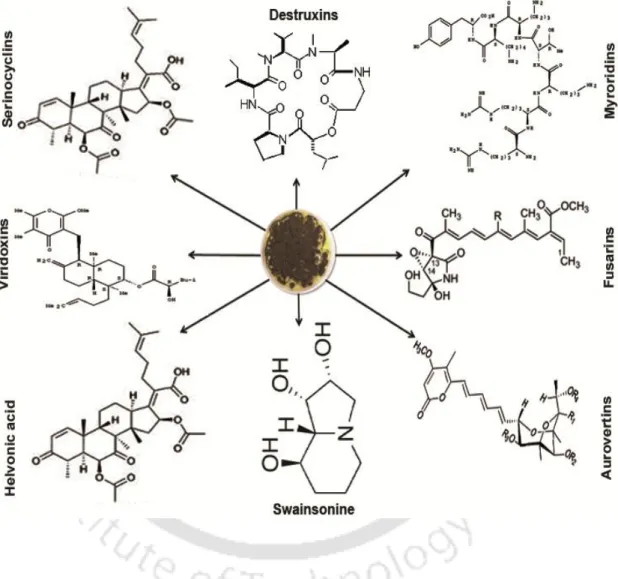
Screening of Metarhizium strains, media components and physiological culture conditions for fermentative
Introduction
Shake flask production of swainsonine was first scaled up at different bioreactor levels by Patrick et al. Fermentative swainsonine production has been reported to be influenced by different strains, production media components, inducers, metal ions, pH and physiological conditions (Patrick et al., 1995; Justo et al., 2007; Tamerler et al., 1998 ). The present study was aimed at the identification, screening and analysis of individuals as well as interaction effects on the fermentative production of swainsonine by Metarhizium anisopliae strains.
Materials and Methods
- Fungal strains, culture and storage conditions
- Chemicals and Reagents
- Sterilization and aseptic techniques
- Dry cell weight method for growth profile studies
- Mannosidase inhibition assay for the quantification of swainsonine
- Screening of Metarhizium strains and growth profile studies
- One factor at a time approach screening
- Plackett-Burman screening
Procedure: The pH of solution II was adjusted to 4.5 by gradually adding solution I and the volume of the mixture was finally adjusted to 100 ml by adding ddH2O. Procedure: The pH of solution II was adjusted to 9.8 by gradually adding solution I and the final volume was adjusted to 100 ml by adding ddH2O. The swainsonine concentration in the culture supernatant was determined using α-mannosidase inhibition assay (Sim and Perry, 1995).
Results and Discussion
- Screening of Metarhizium strains
- One factor at a time screening
- Screening of the basal fermentative media
- Screening of the best carbon sources
- Screening of the best nitrogen sources Complex nitrogen sources
- Screening of the best pH range
- Plackett-Burman screening
Therefore, the additional screening experiments for swainsonine production were performed after 72 h from Metarhizium fermentation broth. The effects of 0.5% (w/v) simple nitrogen sources such as NH2CONH2, (NH4)2SO4, NH4Cl and KNO3 as the potential process parameters were investigated for fermentative swainsonine production from M. Furthermore, swainsonine production was even less with other simple nitrogen sources namely NH2CONH2, NH4Cl and KNO3.
Conclusions
Plackett-Burman (PB) design matrix in real and coded values (in parentheses) together with predicted and experimental swainsonine production by Metarhizium anisopliae ARSEF 1724 (UM8). Screening of (a) glucose concentrations, (b) different carbon sources, (c) complex nitrogen sources, and (d) simple nitrogen sources, for the fermentative production of swainsonine by Metarhizium anisopliae ARSEF-1724 (UM8). Pareto plot of standardized factor effects in the Plackett Burman experiment design (PB-DOE) with (A) glucose, (B) lysine (C) semolina (D) MgSO4.7H2O (E) CaCl2 (F) pH and ( G ) inoculum size, for the fermentative production of swainsonine by Metarhizium anisopliae ARSEF-1724 (UM8).
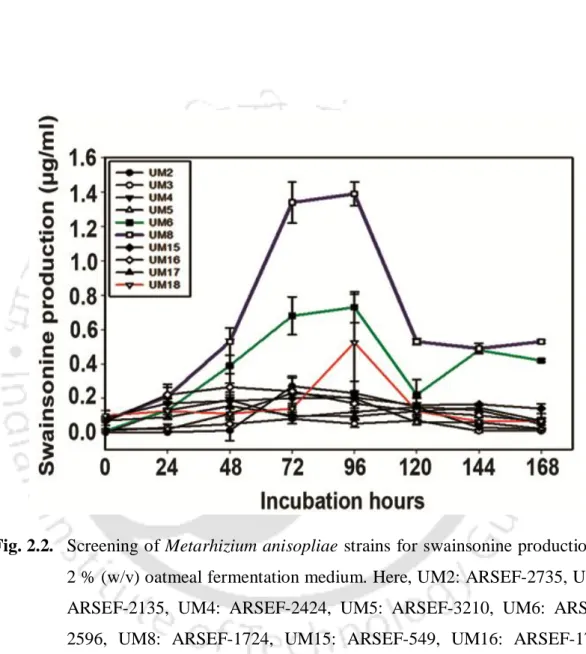
Optimization of media components, operation conditions and scale up parameters from shake flask
Introduction
- Materials and methods
- Fungal strain and culture conditions
- Chemicals and Reagents
- Instrumentation for stirred tank fermentation
- Parameters selected for optimization
- Mannosidase inhibition assay
- Total saccharide estimation
- Growth rate analysis
- Analysis of medium viscosity
- Determination of volumetric oxygen transfer coefficient
- Morphological analysis
- Optimization methodologies 1. Response surface methodology
- Experimental validation of the optimized model
- Results and discussion
- Response surface methodology based statistical optimization of the fermentative medium components
- Shake flask evaluation of swainsonine production as a function of DCW, saccharide concentration and pH
- The artificial neural network-real encoded genetic algorithm based optimization of medium components
- Optimization of agitation and aeration rates at the bench top bioreactor level
- Sequential OFAT screening cum optimization of agitation-aeration rates, analysis of scale up parameter and pellet morphologies
- Optimization of agitation-aeration rates using artificial neural network - evolutionary algorithm
- Validation and analysis of ANN-EA optimized model
- Analysis of scale up parameters (Pg/V L and K L a) for ANN-EA optimized fermentative model
- Conclusions
Metarhizium anisopliae (ARSEF 1724) was purchased from the Plant Protection Unit, United States Department of Agriculture (USDA), New York, Ithaca. Based on the quadratic relationship (Eq. 3.8), 3D response surface curves (Fig. 3.4) were plotted between the swainsonine output (Z-axis) and any two independent variables, keeping the rest of the variables at their optimal levels. Correlation of shear viscosity and shear stress as a function of shear rate in fermentation medium optimized for swainsonine production by Metarhizium anisopliae ARSEF-1724 (UM8) at bench top bioreactor level. a) Estimation of the total oxygen consumption rate and (b) determination of the volumetric oxygen mass transfer coefficient (KLa, s-1) as the slope of equation 3.3 for the 72-90 h incubation period during Metarhizium anisopliae ARSEF-1724 ( UM8) fermentation in the dynamic method.
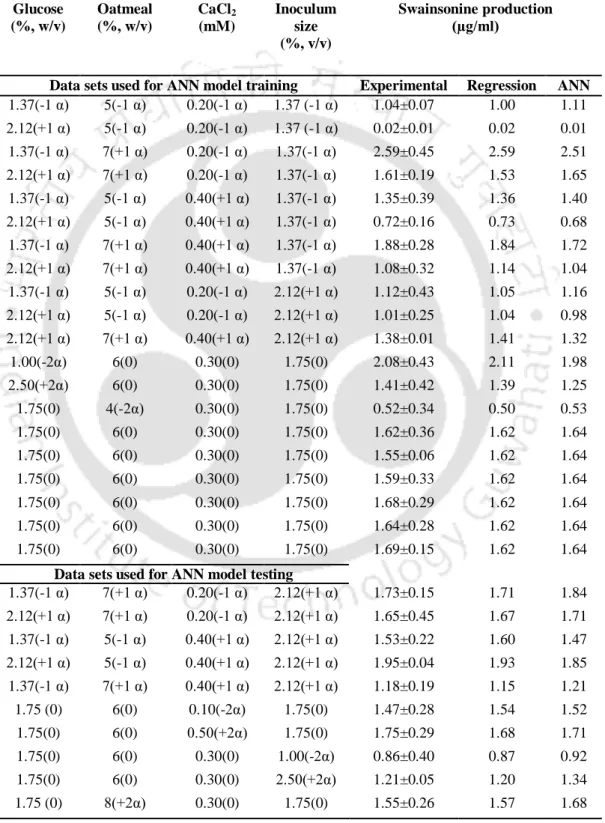
Purification, characterization and quantitative analysis of swainsonine
Introduction
Mass spectrometry (MS) is considered a specific and universal detection method (Molyneux et al., 2002). North America has about 350 different Astragalus and Oxytropis species, while China has about 300 different reported species (Cao et al., 1992; Ping et al., 2009). Microbial production of swainsonine is also being investigated from Rhizoctonia leguminocola (Schneider et al., 1983), Metarhizium anisopliae (Hino et al., 1985; Patrick et al., and fungal endophytes of locoweed (Braun et al., 2003).
Materials and Methods
- Fungal strain and culture conditions
- Chemicals and Reagents
- Swainsonine production
- Swainsonine extraction and partial purification
- Qualitative mass spectrometry instrumentation and analysis of partially purified samples
- Experimental and blank samples for high performance liquid chromatography
- Analytical HPLC Instrumentation and operation conditions
- Mass spectrometry analysis of HPLC fractions
- Preparative cum quantitative liquid chromatography-mass derived instrumentation and operation conditions
- Analytical LC-MS validation of MSD purified broth fractions
The concentration of swainsonine was determined in the culture supernatant and extracted samples using the α-mannosidase inhibition assay as described in section 2.2.1 of chapter 2. Experimental samples, swainsonine extracted from different solvents as described in section 4.2.4 were purified using high performance liquid chromatography (HPLC). Instrumentation and operating conditions Instrumentation and operating conditions.
Results and Discussion
- Solvent extraction, enzymatic quantification and MS analysis
- Quantitative HPLC analysis and method optimization
- Liquid chromatography-mass derived purification
- LC-MSD ESI-MS+ quantification
- Comparative evaluation of conventional HPLC and mass derived quantitative methods
- Limit of detection
- Linearity
- Selectivity and precision
- Inter-method accuracy
- Ruggedness
The elution of large peak before 3 minutes of the initial run of water (Solvent-B) might have led to the poor chromatographic resolution of swainsonine due to its extreme hydrophilicity and polarity (Fig. 4.3a) (Stockigt et al., 2002). Swainsonine elution was therefore further optimized using Method B and Method C, resulting in a large chromatographic peak between elution time 5.59-6.13 min (Fig. 4.3b) and 5.85-6.23 min (Fig. 4.3c), respectively . The chromatographic separation of major peaks in partially purified broth fractions was further confirmed with standard swainsonine runs with elution time 5.95-6.52 min, followed by MS analysis of the HPLC fractions (Fig. 4.3a-b).
Conclusions
Ethanol extraction
A broad outline of the various purification and analytical procedures used for swainsonine from the fermentation broth of Metarhizium anisopliae ARSEF-1724 (UM8). ESI-MS+ qualitative analysis of partially purified swainsonine from the fermentation broth of Metarhizium anisopliae ARSEF-1724 (UM8), (a) swainsonine standard, (b) acetone extracted, (c) samples extracted with 2% acetic acid and chloroform, and (d) samples extracted with ethanol. LC-MS validation of MSD of purified swainsonine from Metarhizium anisopliae ARSEF-1724 (UM8) (a) TIC chromatogram (b) ESI+ scan.
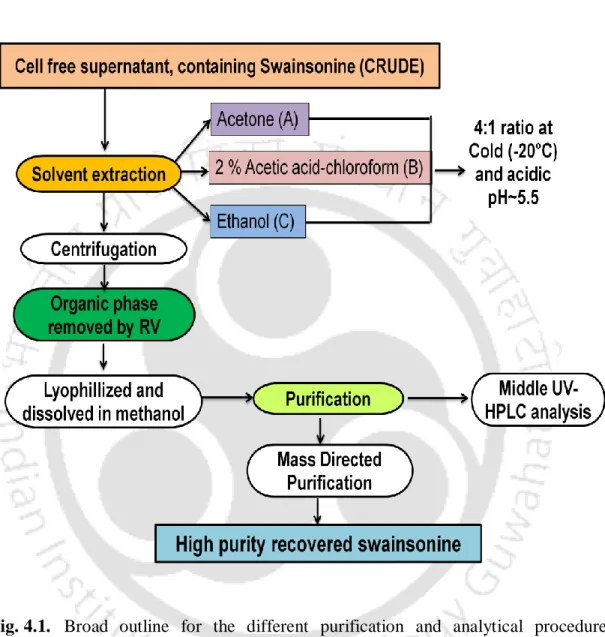
Analysis of in situ entomotoxic and anticancer activities of swainsonine
Introduction
Secondary metabolites with immunosuppressive or otherwise toxic functions can help fungi invade their animal hosts by overcoming cellular and humoral defense systems (Gillespie et al., 2000). These metabolites are toxic to many animals and microbes, including insects, fungi, bacteria and viruses (Carlos et al., 2010). Secondary metabolites from the entomopathogenic fungus Beauveria brongniartii were recently described to induce apoptotic effects in certain pest species, in situ and ex situ (Fan et al., 2013).
Materials and methods
- Microorganism and Cultivation conditions
- Chemicals and Reagents
- Cell culture and treatments
- MTT cell viability assay of Sf-21 and HL-60 cells
- Tryphan blue cell death assay of Sf-21 and HL-60 cells
- Statistical analysis
- Inverted phase contrast microscopy of Sf-21 and HL-60 cells
- Fluorescence microscopy and differential staining using Annexin V-FITC/
- Fluorescence activated cells sorting analysis 1. Apoptosis analysis of Sf-21 cells
- DNA cell cycle analysis of HL-60 cells
- Ultramorphodimensional analysis of Sf-21 cells
- Field emission-scanning electron microscopy
- Atomic force microscopy
The ratio of live to dead cells (cell viability) was determined, standard curves were prepared, and 50% cytotoxic concentrations (CC50), i.e. the concentrations of swainsonine that caused a 50% decrease in cell viability were detd. The ultramorphological examination of the swainsonine-treated Sf-21 cells was performed using various microscopic techniques. The ultramorphology of the swainsonine-treated and control cells was examined using field emission scanning electron microscopy (FE-SEM) (Carl Zeiss, SIGMA VP, USA).
Results and Discussion
- Cytotoxicity analysis of swainsonine for Sf-21 cells
- Cytotoxicity analysis of swainsonine for HL-60 cells
- Inverted phase contrast microscopy 1. Microscopic examination of Sf-21 cells
- Microscopic examination of HL-60 cells
- Fluorescence microscopy and differential staining
- Fluorescence microscopy of Sf-21 cells
- Fluorescence microscopy of HL-60 cells
- Fluorescence activated cell sorting analysis 1. Analysis of apoptosis in Sf-21 cells
- Analysis of DNA cell cycle in HL-60 cells
- Ultramorphodimensional analysis of swainsonine induced apoptosis in Sf-21 cells
The microscopic analysis of swainsonine-treated Sf-21 cells showed characteristic apoptotic features only after 12–36 h after treatment incubation. The treatment with equimolar concentrations of standard swainsonine showed the significant effects only after 48 hours of incubation, with only 29.62% of the cells being arrested in the synthetic phase (Fig. 5.8). The response to irreversible DNA damage in mammalian cells often results in permanent cell cycle arrest. or in many cases cell death by apoptosis (Morgan 2007). The morphological analysis of swainsonine (at IC50 concentrations of standard and purified samples) treated cells showed characteristic apoptotic features only after 12-36 hours of incubation after treatment.
Conclusions
MTT viability and TB dye exclusion cell death assays of Sf-21 cells measured after 36 h with different doses of standard and MSD-purified swainsonine. FACS analysis of swainsonine (IC50 concentrations for standard and purified) treated induced apoptosis in Sf-21 cells in 36 h post-treatment incubations. AFM analysis of control and swainsonine (at IC50 concentrations for standard and purified) treated Sf-21 cells after 36 h post-treatment incubation.
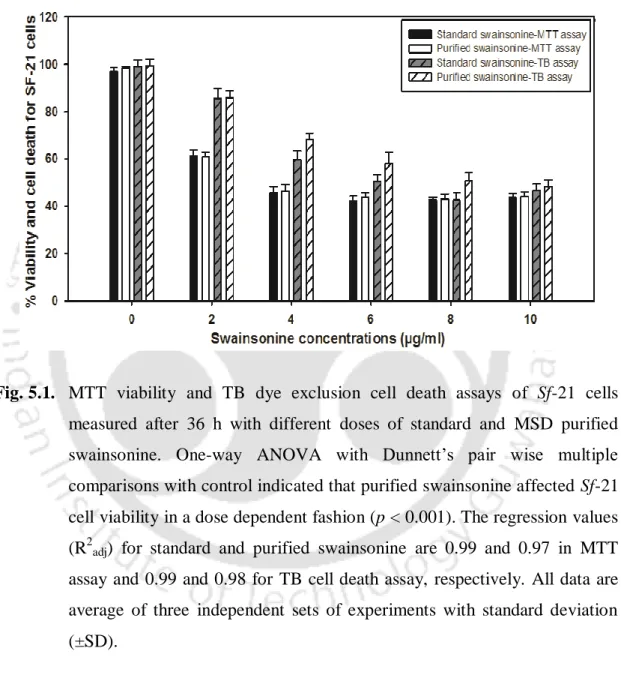
2011) Relative quantification of polyethylene glycol 400 excreted in the urine of male and female volunteers by direct injection electrospray selected ion monitoring mass spectrometry. 2000) Production of ephrapeptins by Tolypocladium species and evaluation of their insecticidal and antimicrobial properties, Mycol. An artificial intelligence approach to Bacillus amyloliquefaciens CCMI 1051 cultures: application to the production of anti-fungal compounds. 1992). 2008) Comparison of artificial neural network (ANN) and response surface methodology (RSM) in optimization of fermentation media: Case study of fermentative production of scleroglucan.
